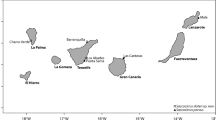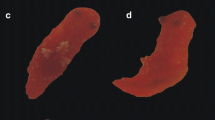Abstract
We describe Speleonectes atlantida n. sp. as the third species of Remipedia that was found outside the main distribution area of this group in the Caribbean region. S. atlantida was collected by cave divers equipped with closed circuit rebreathers from the far interior of the Túnel de la Atlántida, an anchialine volcanic lava tube, on the Canarian island of Lanzarote. The new species occurs in sympatry with S. ondinae, to which it is morphologically closely related. S. atlantida can be distinguished from S. ondinae by a more slender habitus and smaller pleurotergites in the posterior trunk. The valid status of S. atlantida as a new species of Remipedia could be corroborated by intra- and interspecific comparisons of 16S rDNA and CO1 sequence data.





Similar content being viewed by others
References
Carracedo JC, Singer B, Jicha B, Guillou H, Rodríguez Badiola E, Meco J, Pérez Torrado FJ, Gimeno D, Socorro S, Láinez A (2003) La erupción y el tubo volcánico del volcán Corona (Lanzarote, Islas Canarias). Estud Geol 59:277–302
Daenekas J, Iliffe TM, Yager J, Koenemann S (2009) Speleonectes kakuki, a new species of Remipedia (Crustacea) from anchialine and sub-seafloor caves on Andros and Cat Island, Bahamas. Zootaxa 2016:51–66
Edgar RC (2004) MUSCLE: multiple sequence alignment with high accuracy and high throughput. Nucleic Acids Res 32(5):1792–1797
Folmer O, Black M, Hoeh W, Lutz R, Vrijenhoek R (1994) DNA primers for amplification of mitochondrial cytochrome c oxidase subunit I from diverse metazoan invertebrates. Mol Mar Biol Biotechnol 3:294–299
García-Valdecasas A (1984) Morlockiidae new family of Remipedia (Crustacea) from Lanzarote (Canary Islands). Eos 60:329–333
Iliffe TM, Wilkens H, Parzefall J, Williams D (1984) Marine lava cave fauna: composition, biogeography, and origins. Science 225:309–311
Koenemann S, Iliffe TM, van der Ham J (2003) Three new species of remipede crustaceans (Speleonectidae) from Great Exuma, Bahamas Islands. Contrib Zool 72(4):227–252
Koenemann S, Iliffe TM, Yager J (2004) Kaloketos pilosus, a new genus and species of Remipedia (Crustacea) from the Turks and Caicos Islands. Zootaxa 618:1–12
Koenemann S, Iliffe TM, van der Ham J (2007) Micropacteridae, a new family of Remipedia (Crustacea) from the Turks and Caicos Islands. Org Divers Evol 7:52.e1–52.e14
Koenemann S, Ziegler M, Iliffe TM (2008) Pleomothra fragilis n. sp. (Remipedia) from the Bahamas, with remarks on morphologic reductions and postnaupliar development. J Crustac Biol 28:128–136
Kornicker LS, Iliffe TM (1995) Ostracoda (Halocypridina, Cladocopina) from an anchialine lava tube in Lanzarote, Canary Islands. Smithson Contrib Zool 568:1–32
Kornicker LS, Iliffe TM (1998) Myodocopid Ostracoda (Halocypridina, Cladocopina) from anchialine caves in the Bahamas, Canary Islands, and Mexico. Smithson Contrib Zool 599:1–93
Lorentzen D, Koenemann S, Iliffe TM (2007) Speleonectes emersoni, a new species of Remipedia (Crustacea) from the Dominican Republic. Zootaxa 1543:61–68
Palumbi SR, Martin A, Romano S, MacMillan W, Stice L, Grabowski G (1991) The simple fool's guide to PCR (Ver. 2). University of Hawaii Press, Honolulu
Schram FR (1986) Crustacea. Oxford University Press, New York
Schram FR, Yager J, Emerson MJ (1986) Remipedia, Part I. Systematics. Mem San Diego Soc Nat Hist 15:1–60
Stock JH (1987) Stygofauna of the Canary Islands, 5. A hypogean population of Parhyale (Amphipoda) in the Jameos del Agua lava tunnel (Lanzarote), a supposed case of recent evolution. Stygologia 3(2):167–184
Tamura K, Dudley J, Nei M, Kumar S (2007) MEGA4: Molecular Evolutionary Genetics Analysis (MEGA) software version 4.0. Mol Biol Evol 24:1596–1599
Wilkens H, Iliffe TM, Oromí P, Martínez A, Koenemann S (this issue) The Corona lava tube, Lanzarote: geology, habitat diversity and biogeography. Mar Biodiv
Wilkens H, Parzefall J, Iliffe TM (1986) Origin and age of the marine stygofauna of Lanzarote, Canary Islands. Mitt Hamb Zool Mus Inst 83:223–230
Wilkens H, Parzefall J, Ocaña O, Medina AL (1993) La fauna de unos biotopos anquialinos en Lanzarote (I. Canarias). Mém Biospéol 20:283–285
Wollermann U, Koenemann S, Iliffe TM (2007) Cryptocorynetes longulus, a new species of Remipedia from Cat Island, Bahamas. J Crustac Biol 27(1):10–17
Yager J (1981) A new class of Crustacea from a marine cave in the Bahamas. J Crustac Biol 1:328–333
Yager J (1987a) Cryptocorynetes haptodiscus, new genus, new species, and Speleonectes benjamini, new species, of remipede crustaceans from anchialine caves in the Bahamas, with remarks on distribution and ecology. Proc Biol Soc Wash 100:302–320
Yager J (1987b) Speleonectes tulumensis n. sp. (Crustacea: Remipedia) from two anchialine cenotes of the Yucatan Peninsula, Mexico. Stygologia 3(2):160–166
Yager J (1989) Pleomothra apletocheles and Godzilliognomus frondosus, two new genera and species of remipede crustaceans (Godzilliidae) from anchialine caves of the Bahamas. Bull Mar Sci 44(3):1195–1206
Yager J (1994) Speleonectes gironensis, new species (Remipedia: Speleonectidae) from anchialine caves in Cuba, with remarks on biogeography and ecology. J Crustac Biol 14(4):752–762
Yager J, Carpenter JH (1999) Speleonectes epilimnius, new species (Remipedia: Speleonectidae) from surface water of an anchialine cave on San Salvador Island, Bahamas. Crustaceana 72(8):965–977
Yager J, Humphreys WF (1996) Lasionectes exleyi, sp. nov., the first remipede crustacean recorded from Australia and the Indian Ocean, with a key to the world species. Invertebr Taxon 10:171–187
Yager J, Schram FR (1986) Lasionectes entrichoma, new genus, new species, (Crustacea: Remipedia) from anchialine caves in the Turks and Caicos, British West Indies. Proc Biol Soc Wash 99(1):65–70
Acknowledgements
The local Environmental Service of the Cabildo de Lanzarote assisted in gaining access to the Túnel de la Atlántida for diving and collecting samples, and the Consejería de Medio Ambiente of the Canary Government provided the permit to collect endangered species. This study was supported by grants from the German Research Foundation to S. Koenemann (DFG KO 3483/1-1), the US National Science Foundation to T. Iliffe (DEB-0315903), and the Spanish Ministerio de Educación y Ciencias (CGL 2006-01365).
Author information
Authors and Affiliations
Corresponding author
Rights and permissions
About this article
Cite this article
Koenemann, S., Bloechl, A., Martínez, A. et al. A new, disjunct species of Speleonectes (Remipedia, Crustacea) from the Canary Islands. Mar Biodiv 39, 215–225 (2009). https://doi.org/10.1007/s12526-009-0021-8
Received:
Revised:
Accepted:
Published:
Issue Date:
DOI: https://doi.org/10.1007/s12526-009-0021-8




